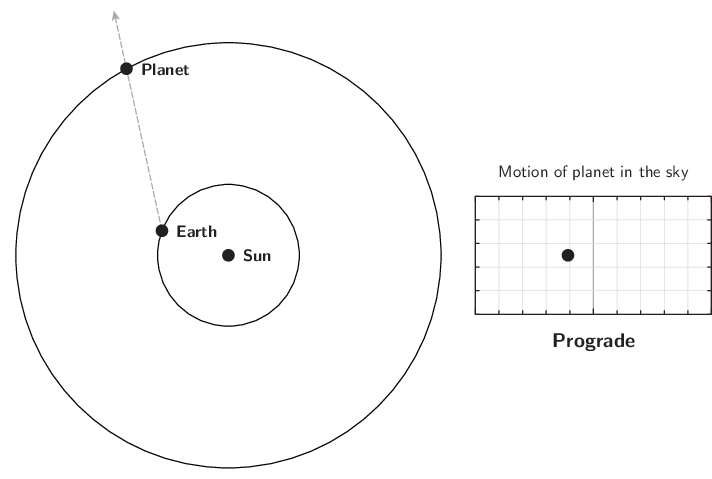Uranus will enter retrograde motion, halting its usual eastward movement through the constellations, and turning to move westwards instead. This reversal of direction is a phenomenon that all the solar system's outer planets periodically undergo, a few months before they reach opposition.
This motion was known to ancient observers, and it troubled them as they could not reconcile it with models in which the planets moved in uniform circular orbits around the Earth, as they believed.
The retrograde motion is caused by the Earth's own motion around the Sun. As the Earth circles the Sun, our perspective changes, and this causes the apparent positions of objects to move from side-to-side in the sky with a one-year period. This nodding motion is super-imposed on the planet's long-term eastward motion through the constellations.
The diagram below illustrates this. The grey dashed arrow shows the Earth's sight-line to the planet, and the diagram on the right shows the planet's apparently movement across the sky as seen from the Earth:

The retrograde motion of a planet in the outer solar system.
Not drawn to scale.
Observing Uranus
Uranus enters retrograde motion as its 2035–2036 apparition gets underway, although it has already been visible for some weeks in the pre-dawn sky.
As retrograde motion starts, it will be visible in the morning sky, becoming accessible around 00:38, when it reaches an altitude of 20° above your eastern horizon. It will then reach its highest point in the sky at 05:56, 78° above your southern horizon. It will be lost to dawn twilight around 05:59, 78° above your southern horizon.
Over the following weeks, Uranus will reach its highest point in the sky four minutes earlier each night, gradually becoming visible in the evening sky, as well as the pre-dawn sky, as it approaches opposition.
As it begins retrograde motion, its celestial coordinates will be:
| Object | Right Ascension | Declination | Constellation | Magnitude | Angular Size |
| Uranus | 07h03m20s | 23°00'N | Gemini | 5.5 | 3.8" |
The coordinates above are given in J2000.0.
The sky on 21 Oct 2035
| The sky on 21 October 2035 | ||||||||||||||||||||||||||||||||||
|
74% 20 days old |
All times shown in PDT.
|
|||||||||||||||||||||||||||||||||
Source
The circumstances of this event were computed using the DE430 planetary ephemeris published by the Jet Propulsion Laboratory (JPL).
This event was automatically generated by searching the ephemeris for planetary alignments which are of interest to amateur astronomers, and the text above was generated based on an estimate of your location.
Related news
| 21 Oct 2035 | – Uranus enters retrograde motion |
| 03 Jan 2036 | – Uranus at opposition |
| 18 Mar 2036 | – Uranus ends retrograde motion |
| 24 Oct 2036 | – Uranus enters retrograde motion |
Image credit
© NASA/Voyager 2


